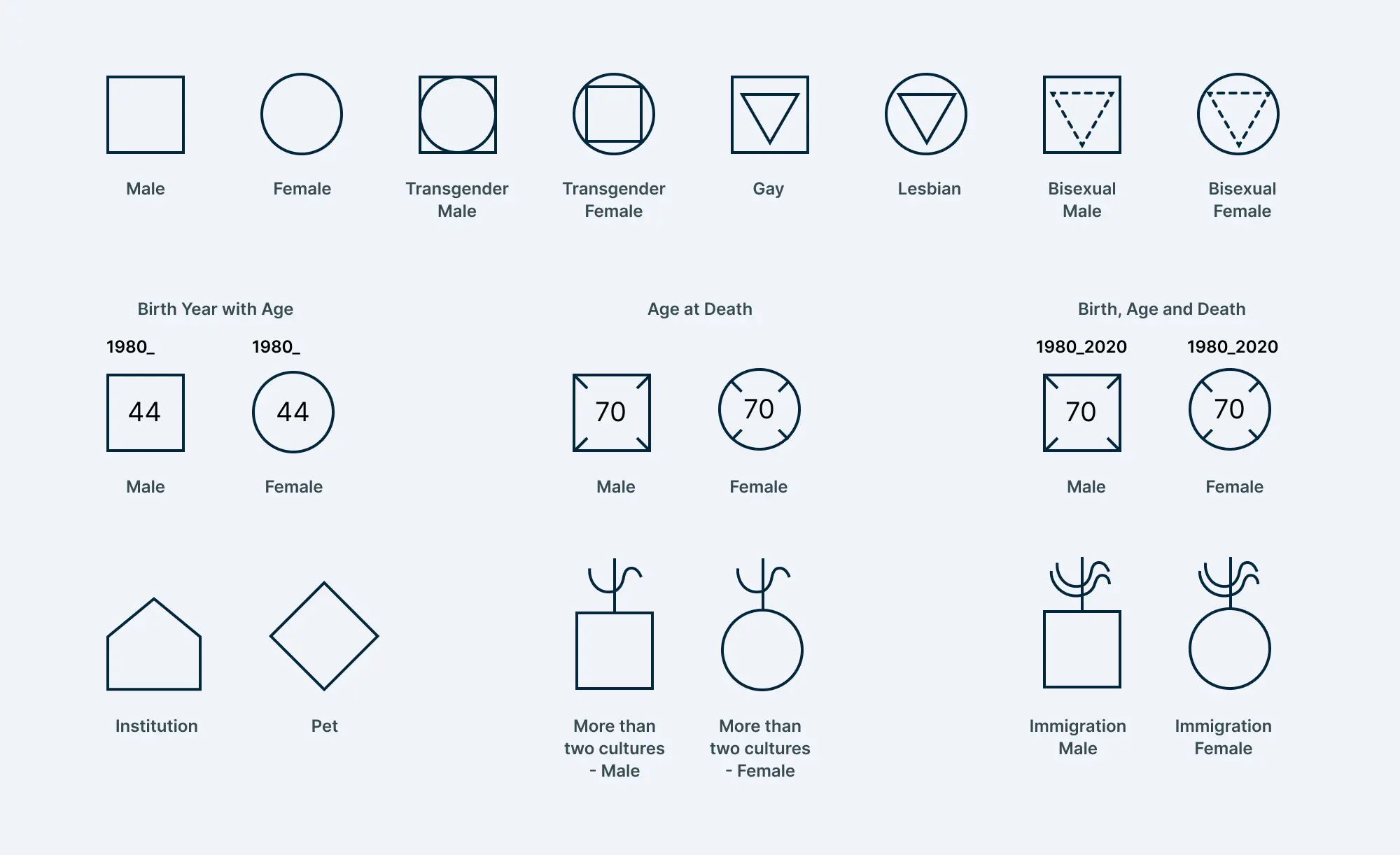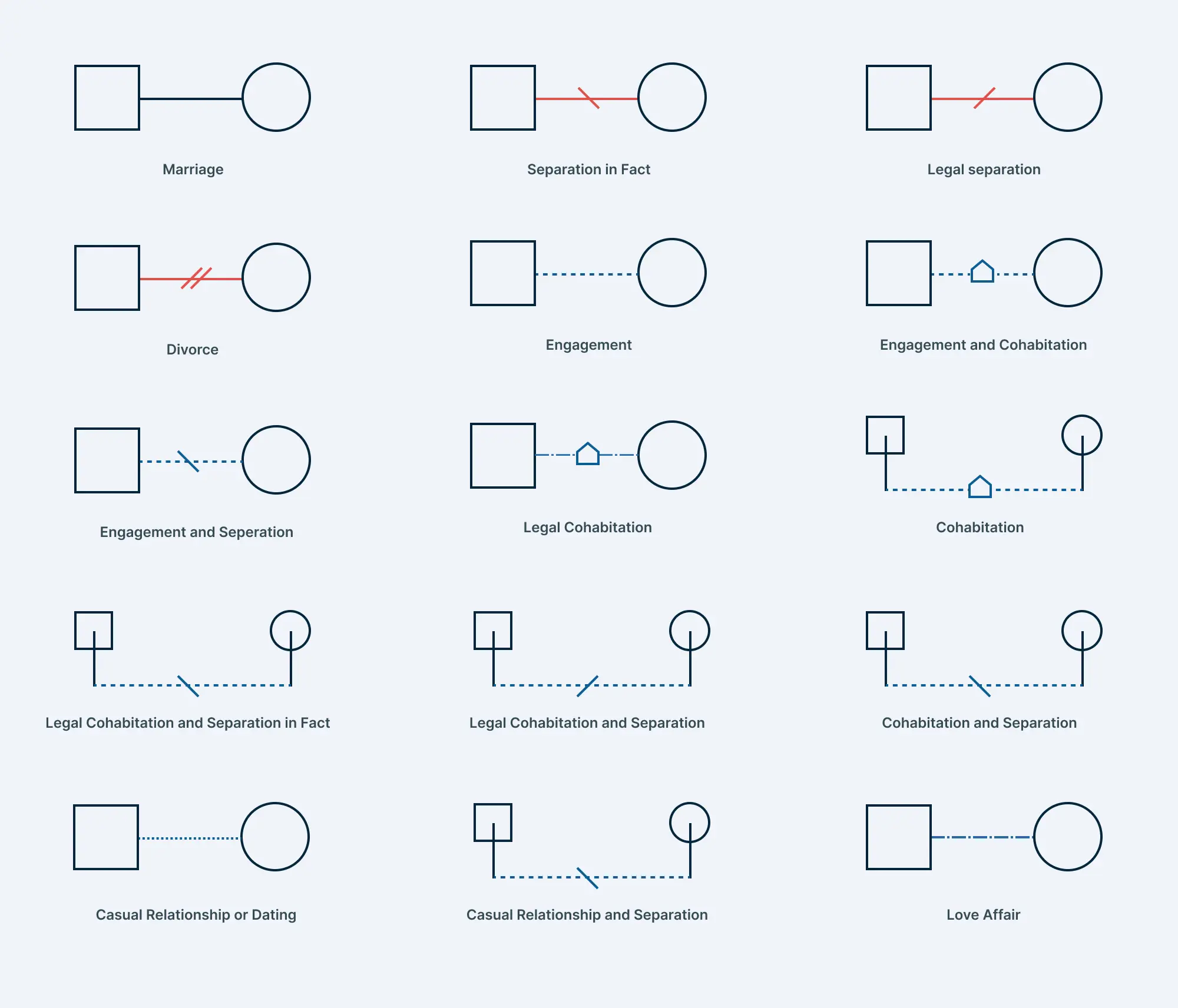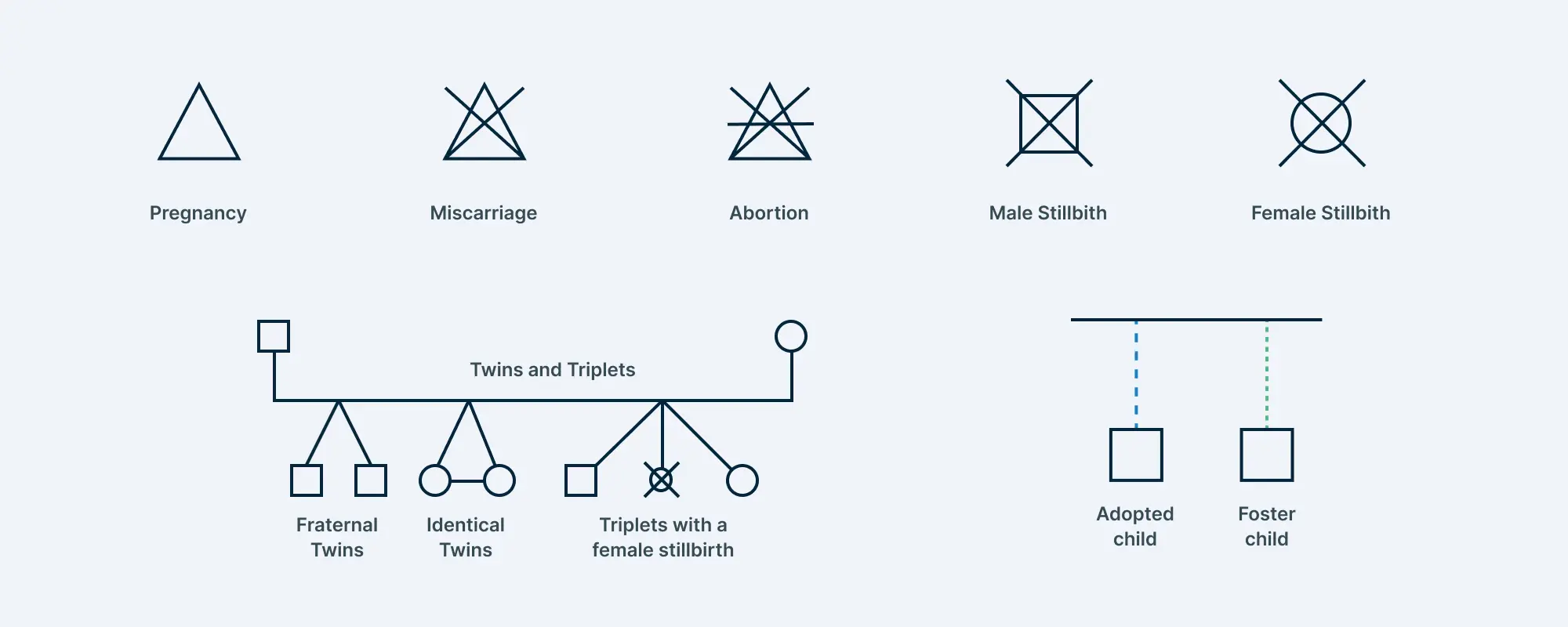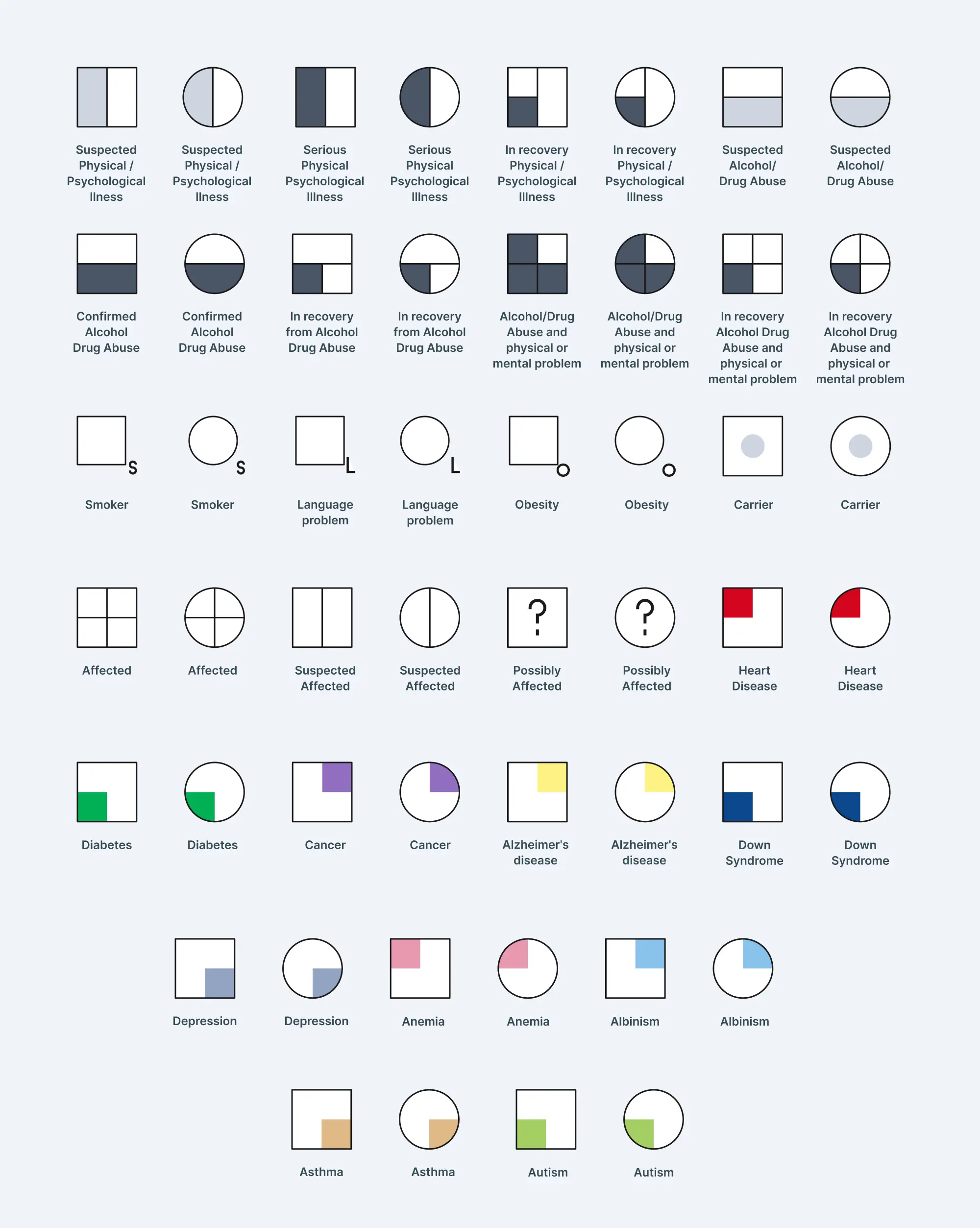Genograms are powerful visual tools that help map complex family relationships. This guide covers essential genogram symbols—from basic structures to emotional and medical connections—making it easier for professionals like therapists, social workers, and healthcare providers and also families to interpret and communicate family histories.
What Are Genogram Symbols
Genogram symbols are standardized graphic representations used to visually map out family dynamics, medical histories, and emotional bonds. These standardized genogram symbols help professionals in various fields such as family therapy, medical practice, and social work to visualize, uncover, and analyze intricate family relationships, behavioral patterns, and more.
Symbols of Genograms: Categories and Meanings
Symbols in genogram can be categorized into four primary types:
- Basic genogram symbols represent gender, birth, age, and other fundamental attributes.
- Family relationship genogram symbols describe the union between two members, such as marriage, engagement, divorce, or separation.
- Emotional relationship symbols indicate different emotional bonds and interactions between family members, such as harmony, conflict, or abuse.
- Medical genogram symbols show medical conditions, hereditary traits, causes of death, and health risks.
What Is a Genogram Legend and Why You Should Use it
A genogram legend or genogram key is a list of symbols which explain their meaning, context, and use-case in a genogram. The genogram legend, similar to a map key, helps interpret the various elements, such as gender symbols (squares for males, circles for females), relationship lines (marriage, divorce, etc.), and other markers like emotional connections or medical conditions. It ensures that the genogram is easy to understand and accurately conveys the intended information.
We have provided a helpful genogram legend in each of the following categories so that you will be able to quickly refer and understand the genogram signs that are relevant to your chosen field.
Genogram Symbols and Meanings
1. Basic Genogram Symbols
Basic genogram symbols create the foundation for building complex family dynamics by representing key personal information. As shown in the genogram legend below, males are represented by squares and females by circles. Other genogram symbols indicate age, birth, death, immigration status, and more.

Gender Symbols
Genograms use a square for males and a circle for females. Generally, the square is placed on the left and the circle on the right of the diagram. There are genogram gender symbols that denote sexual orientation as well.
The transgender symbols use both the square and circle. A female-to-male transgender person is denoted by a square with a circle inside, and a male-to-female transgender person is denoted by a circle with a square inside. A homosexual individual is represented with an inverted triangle within the main member symbol while the bi-sexual symbol uses a dotted inverted triangle.
Birth, Death, and Age Symbols
The birth year is written on the left above the member symbol and the age is mentioned inside the symbol. A deceased member is shown with a cross through the relevant genogram symbol, and the year of death is noted on the upper right. The age at death can be shown inside the symbol.
Other Basic Genogram Symbols
A few other basic genogram shapes indicate relevant data such as an institution or a pet. A pentagon with straight sides and an angular top indicates a significant institutional connection. The pets are shown by a diamond and can be labeled accordingly. Genograms use a wave symbol to indicate if a person has lived in more than 2 cultures. A double wave symbol shows if a person has immigrated.
These basic genogram symbols help professionals capture essential personal information effortlessly. We have listed some genogram questions to help you further enhance the quality of the collected data.
2. Genogram Relationship Symbols/Family Genogram Symbols
Genogram relationship symbols play a crucial role in mapping out family connections with greater depth than a traditional family tree. These family genogram symbols visually represent the dynamics between family members, illustrating not just biological connections but also emotional bonds, conflicts, and marital statuses. By using standardized genogram relationship symbols, you can gain valuable insights into family structures, patterns, and history, making them essential tools in fields like psychology, counseling, and social work.
As shown in the genogram legend below, these genogram relationship symbols cover various aspects of family relationships, including:
- Marital Status: Marriage, divorce, separation, cohabitation, and remarriage.
- Other Unions: Domestic partnerships, engagements, and informal relationships.
- Reproductive Symbols: Indications of pregnancies, miscarriages, and adoptions.
- Parent-Child Relationships: Biological, adoptive, foster, and guardianship relationships.
By interpreting genogram relationship symbols correctly, professionals and individuals can analyze generational patterns, emotional connections, and underlying family dynamics with clarity and precision.

Marital Status Symbols
Genogram relationship symbols offer a clear visualization of marital status, depicting whether individuals are married, divorced, separated, or engaged. A solid line represents a marriage, while a dashed line signifies engagement. Separation after marriage or engagement is shown by a short diagonal through the marriage line while a divorce is indicated by two short diagonal lines.
Other Union Symbols
These genogram relationship symbols are crucial for indicating how family members relate to each other, such as common-law marriages or cohabitation without formal union. Cohabitation is shown by the institution symbol on the relationship line of two dots and a dash while legal cohabitation uses a dot and a dash line. A casual relationship is indicated by a line of dots and a love affair is shown by a dot and dash line in pink. A short diagonal across the relationship line shows the separation of the parties.
Reproductive Symbols
There are several pregnancy-related genogram symbols listed in the genogram legend below. A triangle symbol represents a pregnancy. A triangle with a diagonal cross indicates a miscarriage, and an additional horizontal line signifies an abortion. A smaller square or circle with a diagonal cross indicates a stillbirth. In this case, the square and the circle are half the size of the cross.

Parent-Child Relationships
Parent-child relationships are represented with specific genogram relationship symbols, making family constructs clear and detailed. In the case of multiple births, like twins, triplets, and so on, the child links are joined together. Identical twins are denoted by a horizontal line between the children. If there was a stillbirth in the multiple births, the relevant stillbirth symbol is used with the joined child link.
Adoption and Foster Relationships
These relationships are depicted through specific lines and genogram relationship symbols that differentiate biological children from those who are adopted or fostered. Adoption is typically marked with a dashed vertical line from the parent to the child, while foster relationships might include additional markers.
3. Emotional Relationship Symbols
Emotional relationship symbols in genograms play a crucial role in visualizing the quality of relationships between family members. These genogram relationship symbols help therapists, counselors, and social workers delve into the dynamics of familial interactions and emotional bonds. The use of color-coded genogram symbols as shown in the following genogram legend offers a straightforward way to depict different emotional states and interactions.

Harmonious Relationships
In genogram relationship symbols, a green line typically represents harmonious relationships. Such relationships include friendship, best friends, and love. Generally, these relationships are indicated in green to easily identify them among other relationship dynamics. This color indicates a positive and peaceful bond between family members, making it easy for professionals to spot supportive connections within the family structure.
- Harmony: A solid green line indicates a harmonious relationship with a strong, stable and mutually supportive bond.
- Friendship/ Close: Two dashed green lines indicate a friendship or close relationship between two individuals. The two individuals in consideration are close enough to share secrets with each other.
- Best Friends/ Very Close: Two solid green lines with short diagonal lines show a very close relationship with open and uncensored communication without secrets.
- Love: A solid green line with a small circle in the middle denotes a romantic or affectionate relationship between two people.
- In Love: A solid green line with two interlocking circles illustrates a relationship where two individuals are deeply in love with each other.
Conflict and Tense Relationships
Red lines signify conflict or tension within relationships. They denote emotions like conflict, hate, varying levels of hostility, and violence. These genogram relationship symbols help in identifying areas of strife and disharmony, which are essential for therapists and counselors working to address and resolve family issues.
- Discord/ Conflict: Two red dashed lines represent a conflict or discord between individuals going through a disagreement or tension.
- Hate: Three red dashed lines show an intense dislike or hatred between two people signifying a very negative relationship.
- Hostile/ Conflictual: The red zigzag symbol shows a hostile relationship between two individuals where conflicts and arguments on major issues occur. The level of hostility can be indicated using close-hostile (with a dashed line) or distant-hostile (with two solid lines) symbols.
- Fused: Three red solid lines indicate an enmeshed, overly close, and interdependent relationship where individual choices are set aside for the harmony of the relationship. Fused relationships with hostility or violence are shown with combined symbols.
- Distrust: A solid line with short vertical lines symbolizes distrust between individuals where suspicion or lack of trust is present.
- Violence: A closely set zigzag displays a violent relationship that has conflicts resulting in extreme actions like physical force or excessive power. This can be further detailed by using close-violence (with two solid lines) and distant-violence (with a dashed line) symbols.
Abusive Relationships
Black or blue lines used in genogram relationship symbols indicate abusive relationships. Adding this level of detail is crucial for social workers and therapists when developing intervention strategies and providing necessary support.
- Abuse: This indicates an abusive relationship between two individuals. An arrowhead can be used to show who abuses the other.
- Physical Abuse: This shows that an individual is abusing another individual in a relationship. This includes any non-accidental injury to an individual.
- Emotional Abuse: This symbol denotes any behavior that interferes with the mental health and social development of an individual including yelling, shaming, name-calling, negative comparisons, or any other verbal or emotional abuse.
- Sexual Abuse: This symbol indicates any form of sexually abusive behavior between two individuals including non-consensual sexual acts, sexual harm, or exploitation.
- Neglect (Abuse): This generally indicates failure to provide for a child’s physical needs. This includes factors like shelter, food, clothing, and medical care.
- Manipulative: A manipulative relationship is indicated where one person exerts influence over the other.
- Controlling: This symbolizes a controlling relationship where one individual dominates or restricts the autonomy of another.
Other Relationships
Genogram symbols use specific color codes to depict various other emotions like indifference or detachment. They can be customized depending on the use and indicated in the specific genogram legend. Visualizing relationship dynamics aids in working through familial distance and fostering a more connected environment.
- Indifferent/ Apathetic: A dotted line represents indifference or apathy between two individuals, indicating a lack of strong feelings or emotional connection.
- Distant/ Poor: A dashed line indicates a distant or poor relationship, where emotional connection or interaction is minimal.
- Cutoff/ Estranged: A dashed line with two short vertical lines in the middle shows that the relationship has been severed, indicating estrangement or a complete lack of communication.
- Never Met: A solid line with a small square with a cross symbolizes a relationship where the individuals have never met.
- Focused On: A solid line with an arrow pointing to one individual indicates that person is the focus of the other individual’s attention or interest.
- Focused on Negatively: Similar to the focused-on symbol but with a zigzag represents a negative focus, where one person is the target of another’s negative attention or criticism.
- Fan/ Admirer: A solid line with a small circle in the middle signifies admiration or idolization where one person looks up to or strongly admires the other.
- Limerence: A solid line with two interlocking circles represents limerence, a state of intense romantic obsession or infatuation.
For a practical insight into creating these genogram symbols and effectively utilizing them, you can explore these counseling genogram templates on Creately. Their simplicity and standardization make it suitable for various professional fields, from family therapy to social work.
4. Medical Genogram Symbols
Medical genogram symbols are integral tools for healthcare professionals aiming to map out a patient’s medical history comprehensively. These symbols listed in the following genogram legend provide a visual method to track hereditary conditions, health risks, and causes of death across generations, offering deeper insights into a family’s health patterns.
To explore the vast potential of medical genograms, check out this comprehensive guide on the power of medical genograms.

Medical Conditions
Specific genogram symbols or color codes within genograms denote various medical issues. For example, an individual with a particular genetic condition might have their symbol marked with a special icon or color, helping to identify health risks and hereditary diseases promptly.
Hereditary Traits
Genes play a significant role in familial health. Genogram symbols clearly indicate which traits and conditions might be passed down through generations, aiding medical professionals in predicting and managing these risks.
Causes of Death
Marking the cause of death is crucial for understanding family health trends. Genogram symbols typically present this information next to deceased individuals, providing context on potential health risks related to lifestyle or genetics.
Custom Symbols
Tools like Creately support the customization of unique medical genogram symbols. This functionality ensures that healthcare professionals can create detailed and accurate visual representations tailored to specific medical contexts.
The use of medical genogram symbols offers significant benefits in patient analysis and family counseling. They ensure a clear, standardized way to communicate vital medical information, making it easier for professionals to offer targeted advice and interventions. For example, if multiple family members have a history of heart disease, this can prompt preventive measures for at-risk relatives.
Professionals looking to adopt this approach can leverage Creately’s extensive genogram shapes library and customization options. Creately’s user-friendly platform allows for collaboration, making it easier to create detailed genograms that accurately reflect family medical histories. The ready-made genogram templates also provide plenty of options to start for beginners.
Helpful Resources
Discover what is a genogram and how it works. This guide covers its definition, uses, key benefits, advantages and disadvantages of genograms and limitations—perfect for personal insight or professional use.
Learn how to create a cultural genogram, best practices to ensure cultural accuracy, and free templates to get started.
Learn how to create a medical genogram to track your family’s health history. Discover templates, symbols, and real-life examples to help visualize hereditary medical patterns.
Learn how to create a therapy genogram for clinical practice. Visualize family dynamics, emotional patterns, and health histories with templates and expert tips.
Discover key genogram rules for creating clear and accurate family maps. Learn how to use symbols, lines, and formatting to tell your family's story effectively.
FAQ about Genogram Symbols
What information do basic genogram symbols show?
What do family genogram symbols describe?
What do emotional relationship symbols represent?
What do medical genogram symbols show?
What are the benefits of using Creately for genogram creation?
What are some best practices for creating genograms?
Are there genogram symbols for non-binary people?
How to create genograms using symbols?
Support for all standard genogram symbols, including medical and gender based genograms
Show all types of relationships between member using a simple drop-down menu
Powerful formatting options to show the index person or anything else you like to highlight
Ability to add notes, files, and medical records to do a detailed analysis of individuals
Professionally designed genogram templates to create genograms faster
What are the key benefits of using genograms across different professions?
Understanding Family Dynamics: Genograms visualize familial relationships and interactions, revealing patterns that might not be apparent through traditional methods.
Medical History: Medical professionals use genograms to trace hereditary conditions, helping to predict and manage patient health risks.
Therapeutic Insights: Counselors and therapists employ genograms to visually explore clients’ backgrounds, identifying issues that could impact mental health and personal relationships.
Effective Visualization: Genogram symbols make it easier to visualize and interpret complex family information, aiding in more effective decision-making.
Resources:
Butler, J.F. (2008). The Family Diagram and Genogram: Comparisons and Contrasts. The American Journal of Family Therapy, 36(3), pp.169–180. doi:https://doi.org/10.1080/01926180701291055.
Rempel, G.R., Neufeld, A. and Kushner, K.E. (2007). Interactive Use of Genograms and Ecomaps in Family Caregiving Research. Journal of Family Nursing, 13(4), pp.403–419. doi:https://doi.org/10.1177/1074840707307917.






